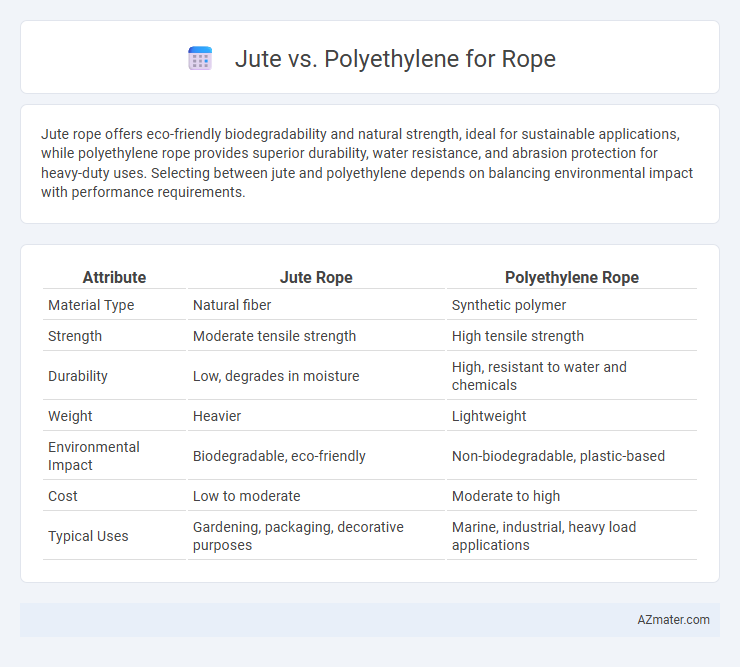Jute rope offers eco-friendly biodegradability and natural strength, ideal for sustainable applications, while polyethylene rope provides superior durability, water resistance, and abrasion protection for heavy-duty uses. Selecting between jute and polyethylene depends on balancing environmental impact with performance requirements.
Table of Comparison
| Attribute | Jute Rope | Polyethylene Rope |
|---|---|---|
| Material Type | Natural fiber | Synthetic polymer |
| Strength | Moderate tensile strength | High tensile strength |
| Durability | Low, degrades in moisture | High, resistant to water and chemicals |
| Weight | Heavier | Lightweight |
| Environmental Impact | Biodegradable, eco-friendly | Non-biodegradable, plastic-based |
| Cost | Low to moderate | Moderate to high |
| Typical Uses | Gardening, packaging, decorative purposes | Marine, industrial, heavy load applications |
Introduction to Jute and Polyethylene Ropes
Jute ropes are natural fibers derived from the jute plant, valued for their eco-friendly biodegradability, strong tensile strength, and excellent grip, making them suitable for marine, gardening, and crafting applications. Polyethylene ropes, made from synthetic polymers, offer superior resistance to water, UV rays, and abrasion, which extends their durability in harsh outdoor environments and industrial use. Both materials provide distinct advantages: jute for sustainable, lightweight needs, and polyethylene for strength and longevity in demanding conditions.
Material Composition and Origins
Jute ropes are composed of natural fibers derived from the jute plant, primarily cultivated in countries like India and Bangladesh, making them biodegradable and eco-friendly. Polyethylene ropes are made from synthetic polymers derived from petroleum, offering superior strength, resistance to moisture, and durability. The distinct material compositions influence their applications, with jute suited for sustainable, low-strength uses, while polyethylene excels in high-strength, weather-resistant environments.
Strength and Durability Comparison
Jute ropes offer moderate tensile strength and biodegradability, making them suitable for light to medium-duty applications. Polyethylene ropes exhibit superior strength and abrasion resistance, providing enhanced durability in harsh environments and heavy-duty tasks. The choice between jute and polyethylene depends on the balance between eco-friendliness and the need for long-lasting, high-strength rope performance.
Environmental Impact and Sustainability
Jute rope offers superior environmental benefits due to its natural biodegradability and renewable sourcing from the jute plant, which requires minimal pesticides and water. In contrast, polyethylene rope, derived from non-renewable petrochemicals, persists in the environment for decades, contributing to plastic pollution and microplastic contamination. Choosing jute supports sustainable agriculture and reduces long-term ecological footprint compared to synthetic polyethylene alternatives.
Water Resistance and Weather Performance
Polyethylene rope offers superior water resistance due to its non-absorbent synthetic fibers, ensuring no weakening or rotting when exposed to moisture, unlike jute which absorbs water and deteriorates over time. In terms of weather performance, polyethylene excels with high UV resistance and durability in harsh conditions, whereas jute degrades faster under prolonged sunlight and humidity exposure. Choosing polyethylene rope guarantees a longer-lasting, low-maintenance solution for outdoor and marine environments compared to the biodegradable but less weather-resistant jute option.
Flexibility and Handling
Jute ropes exhibit superior flexibility and a softer texture, making them easier to handle and knot, especially in applications requiring frequent adjustments or delicate grip. Polyethylene ropes, while offering high strength and durability, tend to be stiffer and less pliable, which can complicate handling in tasks demanding quick or intricate maneuvering. The natural fiber structure of jute contributes to its enhanced grip and flexibility, whereas polyethylene's synthetic composition prioritizes resilience over tactile ease.
Common Applications and Uses
Jute ropes are widely used in agriculture, gardening, and crafts due to their natural biodegradability and excellent grip, while polyethylene ropes are favored in marine, industrial, and outdoor applications for their high strength, water resistance, and durability. Jute's eco-friendly properties make it ideal for packaging, landscaping, and decorative purposes, whereas polyethylene excels in heavy-duty tasks such as towing, fishing, and construction. The choice between jute and polyethylene ropes depends on the need for sustainability versus performance and longevity in various environments.
Cost Analysis and Availability
Jute ropes are generally more cost-effective due to their natural fiber composition and widespread agricultural availability, especially in countries like India and Bangladesh where jute is extensively cultivated. Polyethylene ropes tend to be more expensive initially but offer longer durability and resistance to environmental factors, which can reduce replacement costs over time. Availability of polyethylene ropes is widespread globally, supported by synthetic fiber production, whereas jute's availability may be regionally limited depending on agricultural conditions and harvest seasons.
Maintenance and Lifespan
Jute rope requires regular maintenance such as drying and cleaning to prevent mold and rot, significantly reducing its lifespan in humid conditions. Polyethylene rope is highly resistant to water, UV rays, and chemicals, resulting in minimal maintenance and a much longer lifespan, often exceeding five years in harsh environments. Choosing polyethylene ensures durability and cost-effectiveness for long-term applications compared to the natural but perishable jute fibers.
Choosing the Right Rope for Your Needs
Jute rope offers natural biodegradability and excellent grip, making it ideal for eco-friendly and decorative uses where strength requirements are moderate. Polyethylene rope provides superior water resistance, higher tensile strength, and durability, suitable for marine applications, heavy loads, and outdoor environments. Selecting the right rope depends on weighing environmental impact, strength needs, and exposure conditions to ensure optimal performance.

Infographic: Jute vs Polyethylene for Rope
 azmater.com
azmater.com